In the fact-paced world of startups, every decision matters – including the metrics you track. There’s an overwhelming list of possible KPIs for startups (key performance indicators, but let’s be clear – it’s an absolute waste of time to track certain KPIs.
There are some KPIs that, depending on your objective, feel good but don’t actually reflect the success of your marketing. We like to call these ‘vanity metrics’ – they get some smiles and raise some eyebrows in a board room, but lack the substance that actually indicate true success.
It all comes down to your goals. The number of impressions doesn’t truly matter when you have an acquisition-focused objective. Neither does your click-through rate if you’re solely aiming for brand awareness.
Think of it like training for a marathon versus a sprint. If your goal is to build endurance, you wouldn’t measure success by how fast you can run a single lap. You’d focus instead on distance covered and pacing consistency. But if you’re preparing for a 100-meter dash, your lap time and explosive power matter more than how far you can go. The same applies to marketing KPIs: choose metrics that match your objective, so your data guides you to the right decisions without getting lost in numbers that don’t support your goals.
I never look at KPIs in isolation – they’re always linked to the goal. Our approach to marketing strategy relies on this trio:
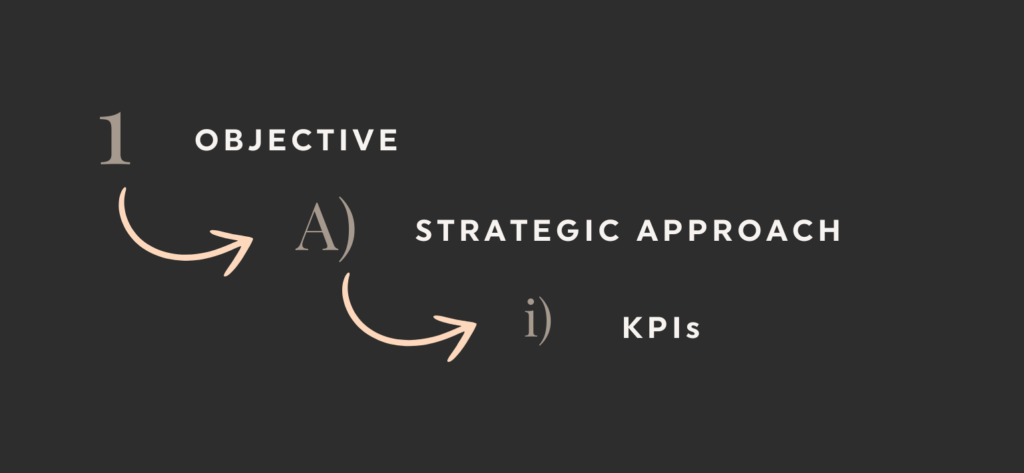
When chosen and used well, KPIs don’t just track progress—they keep you on track, ensuring your marketing strategy stays tightly aligned with your growth goals.
The TLDR here? Don’t just have a list of KPIs – know what you’re measuring and why you’re measuring it, linking it back to your objectives so you have real and relevant indicators of progress.
Let’s break down the essential KPIs every startup and scaling business should be tracking with each objective focus, corresponding with the phase of the customer journey.
01 – Awareness KPIs
Objective focus: Building brand recognition
We all start from somewhere. While startups are often focused on acquisition numbers, we can’t get there without first establishing awareness, so this objective always has a prominent role in a startups first marketing strategy.
- REACH: Measures the total number of people exposed to your brand over a period. This can be monitored through impressions on social media, display ads, or website visits. It’s a straightforward metric that gives you a bird’s-eye view of brand exposure.
- brand impressions: Particularly valuable on social channels, brand impressions indicate the frequency that people see your content. High brand impressions, when paired with strong engagement, signal that your brand is gaining traction.
- I always have a caveat with this one, however, as it can be completely correlated with the advertising budget you put behind it. You want impressions, yes, but are they impressions from the right audience? Are they interacting with the content in any way? I like to follow it up with audience context and (light-touch) engagement metrics (e.g. likes, comments, etc.).
- SHARE OF VOICE (SOV): By tracking how often your brand is mentioned compared to competitors, SOV offers insight into your industry position. This often requires additional tools and warrants a post all of its own, but initially, you can focus on a particular channel, calculating the following:
- SOV IN PAID ADVERTISING use tools like Google Ads or SEMrush to see estimates of competitors’ ad spend and impressions, which you can compare to your own to gauge paid ad SOV.
- SOV IN ORGANIC SEARCH: Tools like Ahrefs, SEMrush, and Moz can help track the percentage of organic traffic or keywords your brand ranks for compared to competitors. You can also look at estimated traffic for specific high-value keywords.
- SOV IN SOCIAL MEDIA: Social listening tools like Brandwatch, Sprout Social, or Hootsuite track mentions across platforms. Measure your mentions compared to competitors’ within a specific time frame to gauge your social media SOV.
- SOV IN PR/PAID MEDIA: PR tools like Meltwater or Cision can provide insights into how often your brand is covered versus competitors. Compare your media coverage volume, reach, and sentiment against key competitors.
For example:
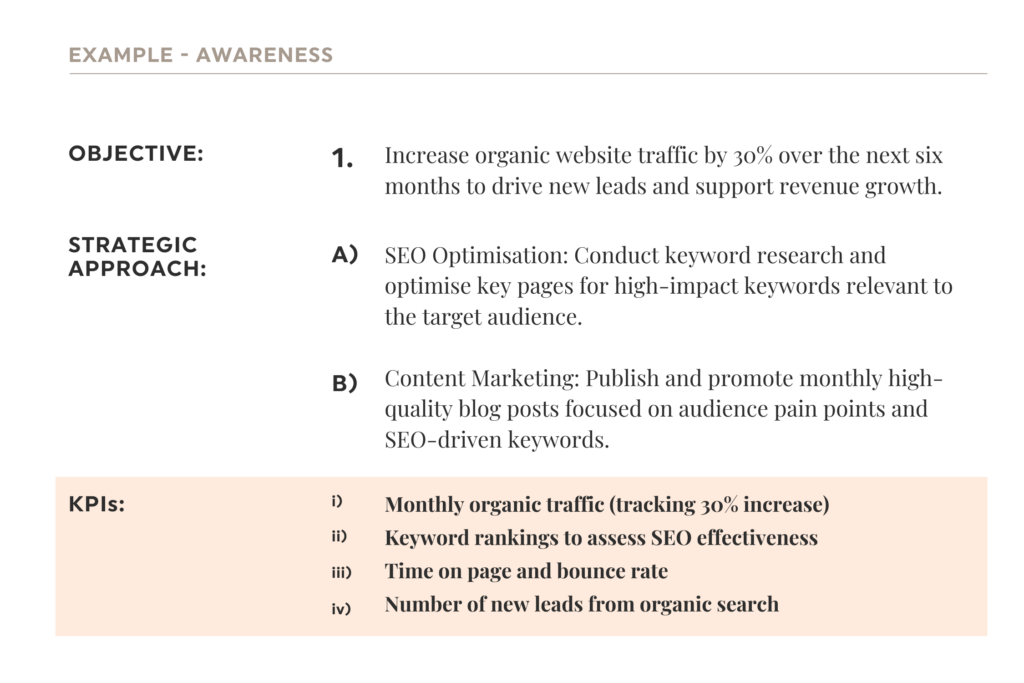
02 – Consideration KPIs
Objective focus: Capture Interest & Drive Engagement
Awareness is great, but it’s not traction. Consideration KPIs help you gauge if potential customers are actively engaging with your brand.
- ENGAGEMENT RATE: The ratio of interactions (likes, comments, shares) to total reach. This KPI is crucial for understanding the quality of your content and how well it resonates with your audience.
- CLICK-THROUGH RATE (CTR): Measured across email, social, and digital ads, CTR shows how often people click on your content relative to impressions. A high CTR suggests that your messaging and creative are driving interest.
- TIME ON SITE: Tracking how long users spend on your website is key to understanding content relevance. High time on site indicates strong interest, while low time may reveal UX or targeting issues.
- LEAD CONVERSION RATE: Track the percentage of website visitors who convert into leads via content downloads, demo requests, or contact forms.
- GROWTH IN QUALIFIED LEADS: Monitor the monthly increase in qualified leads that come from the content nurturing sequence and retargeting ads, aiming for a consistent 20% rise over three months.
For example:
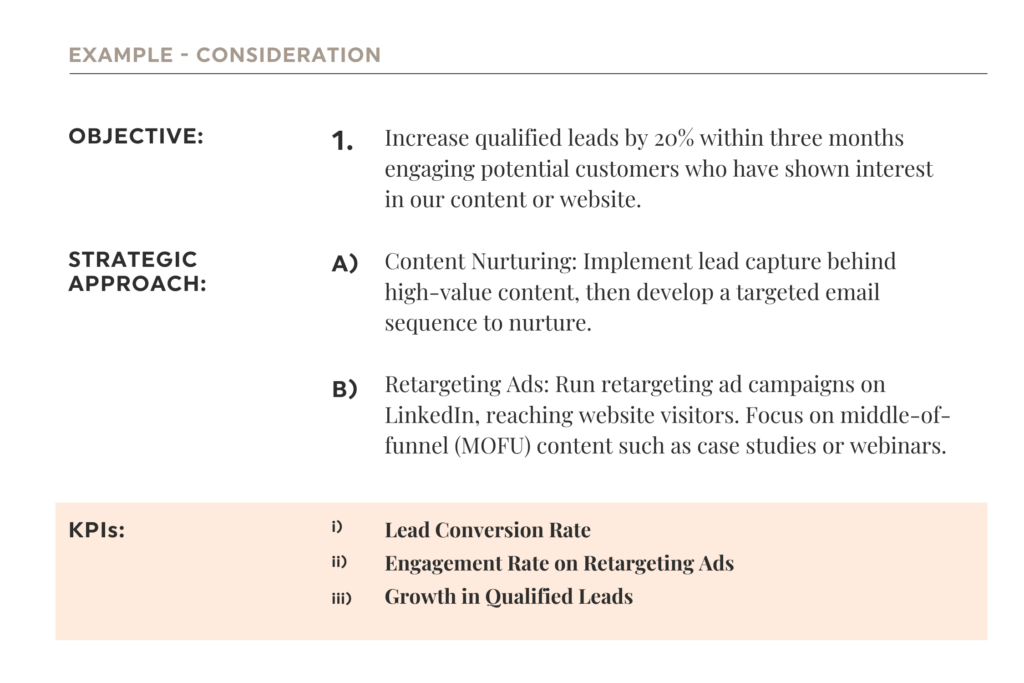
03 – Acquisition KPIs
Objective focus: Convert Interest into Action
This is what it’s all for. At the acquisition stage, your essential marketing KPIs are all about the conversion from interest into customers.
These are the KPIs that investors get a little high on, but they can’t be the only measure. We can’t expect customers to go from 0-100 immediately – it’s a process.
That said, I get a little high off these KPIs too:
- CUSTOMER ACQUISITION COST (CAC): CAC measures the cost of acquiring each customer and is a critical KPI for startups, especially when scaling. This is classically looking at paid advertising spend, but your content development costs should be factored in as well.
- CONVERSION RATE: A core metric for e-commerce and SaaS startups, conversion rate tracks the percentage of users taking desired actions, such as sign-ups or purchases. Knowing your conversion rate helps you pinpoint funnel bottlenecks.
- LEAD-TO-CUSTOMER CONVERSION: This KPI reflects the effectiveness of your sales process in converting leads. A low ratio may indicate unqualified leads, while a high ratio suggests a well-aligned sales process.
For example:
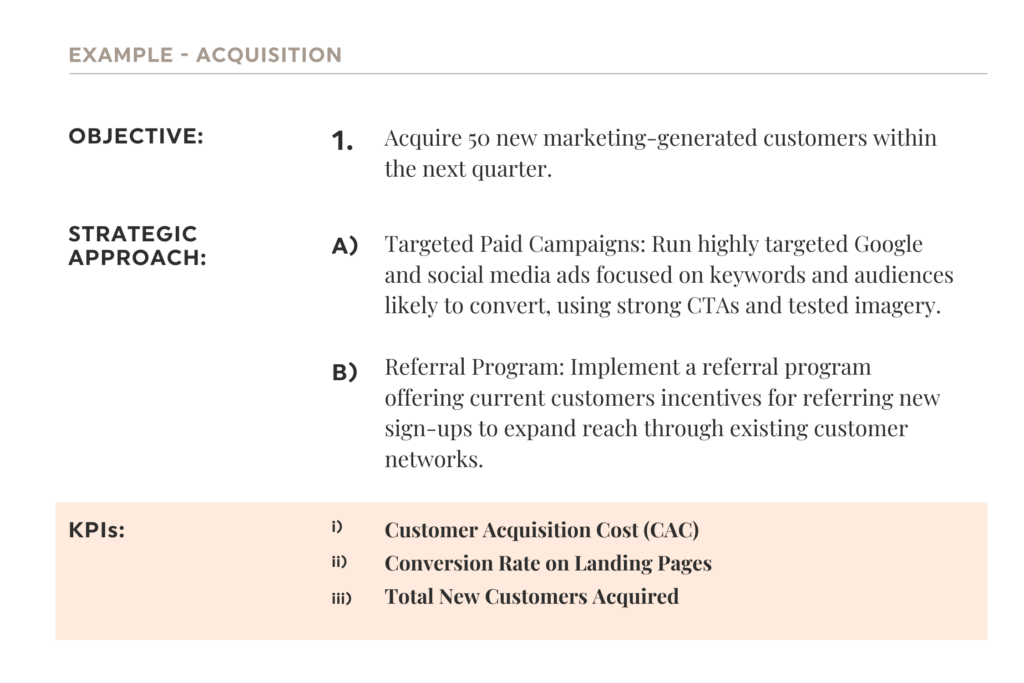
04 – Retention KPIs
Objective focus: Keep Customers Coming Back
Retention KPIs focus on building a loyal customer base, which is crucial for startup growth. These essential marketing KPIs are often overlooked but can make or break your success.
- CUSTOMER LIFETIME VALUE (CLTV): estimates the total revenue expected from a single customer over time. High CLTV compared to CAC suggests a sustainable business model.
- CHURN RATE: Tracking the percentage of customers who stop doing business with you helps identify product or service issues. A low churn rate indicates high customer satisfaction and loyalty.
- NET PROMOTER SCORE(NPS): This qualitative KPI assesses customer loyalty by asking how likely they are to recommend your product. NPS is an indicator of long-term growth potential and brand advocacy.
For example:
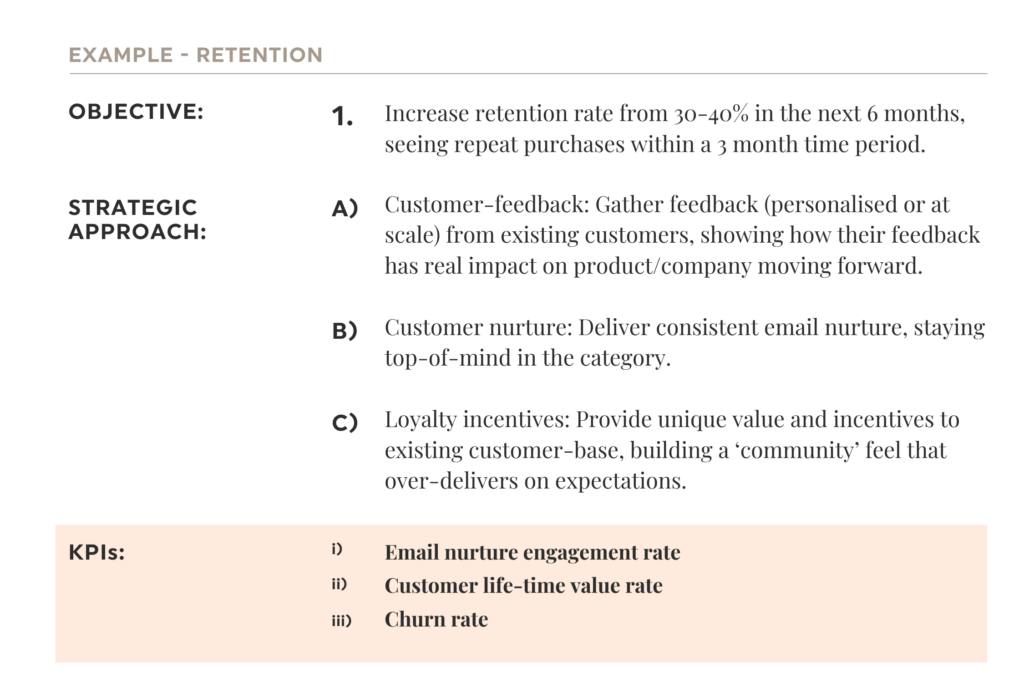
05 – Revenue & Profitability KPIs
Objective focus: Maximise revenue & ensure sustainable growth
While not part of the customer journey itself, every good marketing lead needs a clear grasp on the revenue and profitability metrics surrounding their marketing. I firmly believe marketers need to be able to participate in finance and operations discussions, winning over the hearts and minds of COOs and CFOs as we do. To do this, we need to track revenue and profitability KPIs – aka the life and death of a startup. This is where marketing efforts and financial growth become one.
- REVENUE GROWTH RATE: This KPI tracks growth over time, helping you adjust your strategy to maintain upward momentum. Investors often look at revenue growth as a marker of growth potential. While correlation does not equal causation, you can analyse the relationships between marketing campaigns, spend and incoming revenue. (Also take a look at what was happening 6 months prior – brand-level campaigns have an impact on the bottom line.)
- RETURN ON MARKETING INVESTMENT (ROMI): ROMI is calculated by dividing the revenue from marketing campaigns by campaign costs. This KPI is crucial for understanding the efficiency of your marketing spend and helps you refine budget allocation.
- GROSS PROFIT MARGIN: Tracking the margin between sales revenue and production costs provides a clear picture of profitability, allowing startups to reinvest for future growth.
As marketers, we should always be able to answer whether a campaign was successful enough. Even when the CEO asks and all eyes are on you in a boardroom, it depends. It depends on the established context, phase in the customer journey, and corresponding objective. Did an awareness campaign result in an immediate customer?
No. It’s not expected to.
A campaign is successful pending the objective and relevant metrics associated with it.
And let’s remember, we’re not tracking all of these KPIs at any given time, because we don’t have objectives at each level of the customer journey. That’s the equivalent of having no objectives, because your focus is too wide-spread. Ideally you’ll hone in on 2 objectives, maybe 3, vastly refining your list of relevant KPIs.
Tracking the right KPIs is essential to driving meaningful growth in any startup. By focusing on essential marketing KPIs aligned with key objectives—like awareness, consideration, acquisition, and retention—you can transform raw data into actionable insights. This not only clarifies your strategy but also ensures every marketing dollar is working towards your growth goals.
If you’re ready to focus on metrics that matter, start with your objectives and work in these essential marketing KPIs for your startup, letting the data guide your success.
If you’d like support on developing your marketing strategy, feel free to get in touch! We can provide ad hoc support or work in partnership with you to establish the strategic foundation that supports the success of your marketing campaigns.

+ show Comments
- Hide Comments
COMMENT